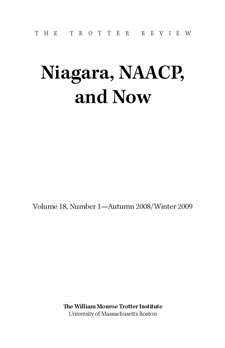Volume 18, Issue 1 (2009) Niagara, NAACP, and Now
A day or two after Barack Obama was elected president, a colleague with an international reputation for political savvy commented that George W. Bush had made it possible for Obama to be president.
“No,” I responded. “You can’t give that to Bush single-handedly. There is a whole history, a backlog of effort, not to mention Obama’s strategic genius, to explain the outcome of the election. Bush may have weakened the gate, but Obama pushed it open, and he had a whole group of folks, much bigger and more diverse than the Verizon network, behind him.”
The idea that white folks are the ones who make things happen, that they are the motive force fueling any black accomplishment, persists as a misconception. White folks have agency, black folks do not; white folks are doers, black folks are takers. Of course, not everyone thinks or feels that way, but some still do, and not necessarily through individual fault alone. The media often subscribe to the notion that accomplishment is an exception for blacks, not a given. Rather, criminality is their constant, and so too disadvantage.
The Niagara Movement, the historical focus that begins this issue, was conceived in the idea that blacks can work together in concerted fashion to better their circumstances on a broad slate, including education, law, suffrage, transportation, justice, economics, health, arts, and media. The year of its founding was 1905. At the time, blacks, who were then referred to as Negroes, were suffering hard times, having been relegated to legally-inequitable living and educational conditions and being routinely tortured and killed in public as a form of social sport. In a practice known as lynching, southerners and some northerners strung trees thick with black bodies, eyeing them as little more than expendable baubles, like Christmas trinkets garishly displayed.
From the Introduction by Barbara Lewis.
Front Matter
Articles
Introduction
Barbara Lewis
Race, Politics, and Public Housekeeping: Contending Forces in Pauline Hopkins’s Boston
Betsey Klimasmith
The Brownsville, Texas, Disturbance of 1906 and the Politics of Justice
Garna L. Christian
Oral Histories of the Springfield, Illinois, Riot of 1908
Edith Carpenter, Albert Harris, Nathan L. Cohn, Mattie Hale, and Sharlottie Carr
From Thurgood
George Stevens Jr.
The Racial History of Juvenile Justice
Geoff K. Ward
Her Thirteen Black Soldiers
Archibald H. Grimké
The Houston Mutiny of 1917
Garna L. Christian
The NAACP in the Twenty-first Century
Dianne M. Pinderhughes
Commentary
Kenneth J. Cooper
Back Matter

Editors
- Editor
- Kenneth J. Cooper
- Director, Trotter Institute
- Barbara Lewis


